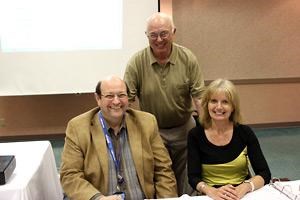No one disagrees that the ferries on the Powell River-Comox and Texada Island routes need to be replaced. But how and when they will be replaced is a subject of concern for both community leaders and residents.
Scott Randolph, Powell River Regional Economic Development Society manager, made a presentation about the issue at the April 24 meeting of the Northern Sunshine Coast Ferry Advisory Committee. He pointed out there have been two rounds of consultation on the vessel replacement strategy, in 2004-2005 with BC Ferries and in 2010 with the ministry of transportation and infrastructure. There has been no movement on the issue, he added, even though both the Queen of Burnaby and North Island Princess are past their prime.
“We have now been hearing that contrary to feedback from the community during consultation, which was status quo, that BC Ferries is considering putting two medium-sized vessels on the Comox and Texada routes with a modified schedule,” he said. “Going with smaller vessels and a reduced schedule will have significant economic impacts on the region.”
Investment and visitor attraction and business retention and expansion are problematic at best due to the current cost of ferry service, Randolph added, and there’s also a concern that the community may end up having to deal with more cancelled sailings caused by a heavy-weather decision matrix and the possibility of overloads during the peak tourism season.
If there is a different strategy than the one the community agreed on during consultation, BC Ferries and the provincial government have to come to the community and have a frank discussion with residents on what future service will be, Randolph said.
Ken White, a committee member appointed by the City of Powell River, read a statement on behalf of the committee, which stated that BC Ferries should consult again with both Powell River and Texada residents before any new ferries are built for these routes, “since the last ferry consultation is many years outdated.”
Chair Bill Cripps, also appointed by the city, pointed out that the committee had stated as far back as 2005 that it was looking for “like-for-like” for both vessel size and service. “We were opposed to two 85-car, medium-sized ferries on a triangle route between Vancouver Island, Powell River and Texada,” he said.
Rob Clarke, BC Ferries vice-president and chief financial officer, said the strategy that was developed and the consultation that was done back in 2004 and 2005 was a contractual obligation of BC Ferries to the provincial government, as part of the Coastal Ferries Services Contract, which is the vehicle by which the government governs its transportation policy responsibilities.
The document, called the Northern Sunshine Coast Vessel and Service Strategy, was delivered to the province in 2005, Clarke said, and it belongs to the government. “The whole question here is a transportation policy question, which is a provincial government mandate, not a BC Ferries mandate. BC Ferries has some opinions on this, but we have not, as of this point, had a formal response from government on this issue.”
BC Ferries is in a position of having to build like-for-like, Clarke said, however, that doesn’t mean the Queen of Burnaby will be replaced with a similar-sized vessel. “Like-for-like means that the service will stay the way it is and the ferries will be built sized to the demand on those routes, which will not be 192 cars,
that I can assure you.”
Addressing the concern about more sailing cancellations in the winter, Clarke said the design of the ferry was key, not the size. He also said BC Ferries thought there might be an overall improvement of service with the Powell River-Texada Island-Comox triangular route concept.
He would be surprised if the government didn’t consult with the community, Clarke also said, and the company will participate in the consultation. BC Ferries needs a new ship in service on Route 17 by April 1, 2016, Clarke said, adding the process takes about three years.



